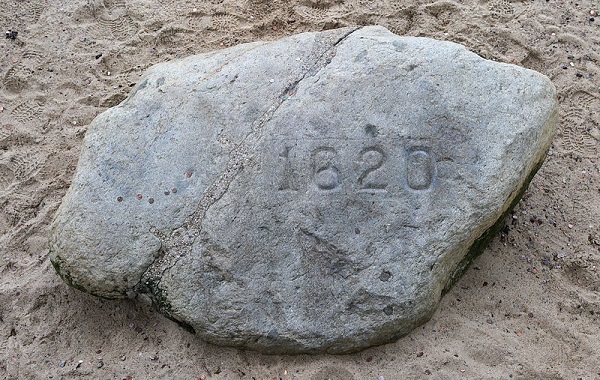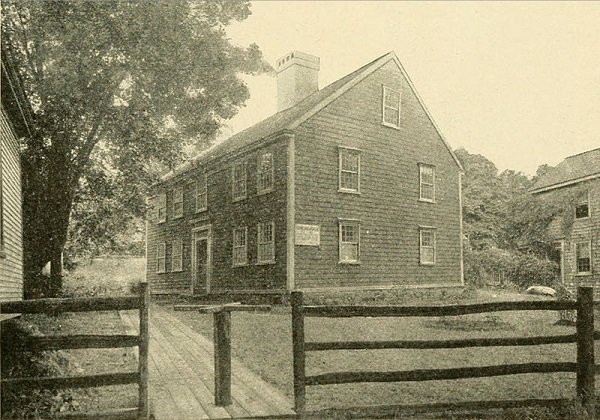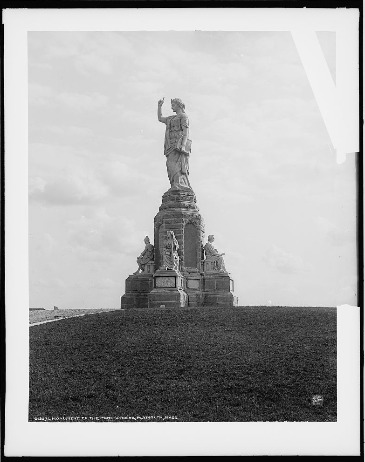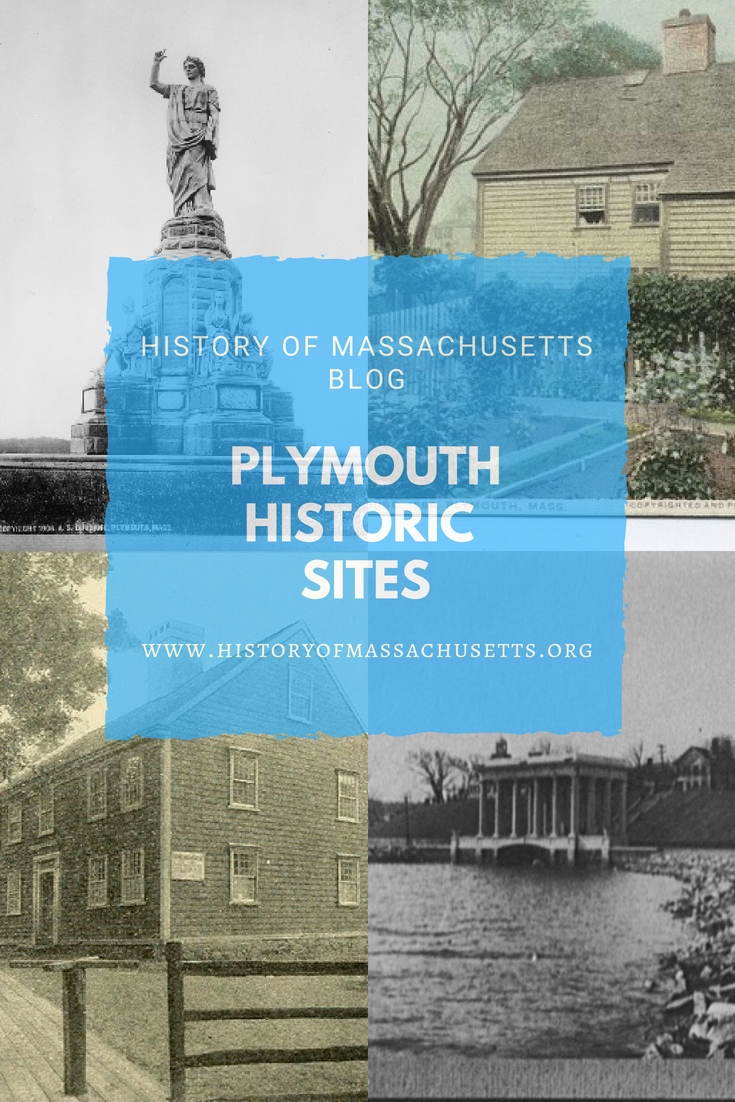Established in 1620, Plymouth, which is the site of the historic Plymouth Colony, is the oldest town in Massachusetts.
The town has numerous historic buildings, old cemeteries as well as ancient Native-American sites. Many of the historic buildings are now Plymouth history museums and contain artifacts, exhibits and collections that explain the historic events that happened there.
Visiting these historic sites in person is a great way to experience this history firsthand. You can see the sites on the list by exploring them on your own or by taking a Plymouth walking tour or a Cape Cod Tour.
The following is a list of Plymouth’s historic sites:
Plymouth Rock:
Address: 79 Water Street, Plymouth, Ma
According to local legend, Plymouth Rock marks the spot where the Mayflower Pilgrims first came ashore after reaching Plymouth in 1620.
The claim originates from 1741 when a 94-year-old man named Thomas Faunce stated that his father, who arrived in Plymouth in 1623, and several Mayflower passengers, told him the stone was the specific landing spot.
In 1774, during the build up to the Revolutionary war, the town residents tried to move the rock from the harbor to a liberty pole in front of the town’s meetinghouse and accidentally broke it in half. The bottom portion was left at the harbor while the top portion was brought to the town square.

In the 1860s, a canopy was constructed to cover the bottom portion of the rock that was still located at the harbor and the stone was trimmed down to fit inside the structure.
In the 1880s, the top portion of Plymouth Rock was reunited with the lower portion at the harbor where it was cemented back together and the date “1620” was carved into the stone.
In 1920, a Roman temple-esque structure was built to cover the stone. The stone now sits on a sandy bed five feet below sea level, encased in an enclosure. The rock is estimated to be only a third or half of its original size.
Years later, it was discovered that a slab of the rock was being used as a doorstop at a historic house in Plymouth. The Plymouth Antiquarian Society donated the slab to the Pilgrim Hall Museum where visitors are allowed to touch it.
The rock was added to the National Register of Historic Places in 1970.
Sacrifice Rock:
Address: 394 Old Sandwich Road, Plymouth, Ma
Website: www.plymouthantiquariansociety.org/historic.htm
Sacrifice Rock is a historic Native American site in the Pine Hills region of Plymouth. The site is owned by the Plymouth Antiquarian Society.
The site was where traveling Wampanoag would stop and place small branches or stones on top of the large rock. It is believed this was either a gesture of sacrifice or a request for a blessing for safe passage, but the exact meaning is unknown.
Over time, the small collection of sticks created a large stick formation but it was later destroyed by a fire.
In 1928, the land where sacrifice rock is located was given to the Plymouth Antiquarian Society by Abbott A. Raymond.
In 1940, cement posts were constructed to mark the site. In 1960, a commemorative stone marker was added to the site and 1991 it was replaced by a metal plaque, which is still there today.
Cole’s Hill:
Address: Carver St, Plymouth, Mass
Established in 1620, Cole’s Hill is the oldest cemetery in Plymouth. The colonists did not place headstones in the cemetery but passed down stories that the place was a burial ground.
In the 18th century, the hill was used as a military fortification due to its height and view of the harbor. In 1735, bodies were discovered there when a rainstorm washed away a section of the hill and swept human remains into the harbor.
In the 19th century, more bodies were discovered due to soil erosion and others were uncovered during public works projects.
In 1920, during the town’s tricentennial, a sarcophagus was placed on top of the hill and the remains were placed inside.
The cemetery contains the graves of many of the Mayflower pilgrims.
Coles Hill was designated a National Historic Landmark in 1960 and was added to the National Register of Historic Places in 1966.
Burial Hill:
Address: School Street, Plymouth, Ma
Website: www.plymouth-ma.gov/cemetery-and-crematory-management/pages/burial-hill-cemetery
Burial Hill is the second oldest cemetery in Plymouth. The exact date it was established is unknown. The site was originally the location of the colonist’s old stone fort, which was built in 1621-22 and was also used as a meeting house.

After King Phillip’s War ended in 1676, the fort was abandoned and the hill began to be used as a burial ground.

Burial Hill was added to the National Register of Historic Places in 2013.
Richard Sparrow House:
Address: 42 Summer Street, Plymouth, Ma
Website: www.sparrowhouse.com/SparrowMain.htm
Built around 1640, the Richard Sparrow House is the oldest surviving house in Plymouth. The house was built by Richard Sparrow, an English surveyor who arrived in Plymouth Colony in 1636. It remained in the Sparrow family until 1653 when it was sold to George Bonum.
The Richard Sparrow House now operates as a historic house museum and gallery. The museum is open daily from 10am to 5pm.
The house was added to the National Register of Historic Places in 1974.
1677 Harlow Old Fort House:
Address: 119 Sandwich Street, Plymouth, Mass
Website: www.plymouthantiquariansociety.org/historic.htm
Built in 1677, this gambrel-roof first period house was built by settler William Harlow. The house is built from materials from the pilgrim’s old fort at Burial Hill after it was dismantled in 1676 when King Phillip’s war ended.
In 1920, the house was purchased by the Plymouth Antiquarian Society who restored it to show the early hall with its central hearth and wide board flooring. In 1922, the house opened as a historic house museum.
The house was added to the National Register of Historic Places in 1974.
Jabez Howland House:
Address: 33 Sandwich Street, Plymouth, Mass
Website: www.pilgrimjohnhowlandsociety.org/howland-house
Built in 1667, this first period two-story timber framed house is the only existing house in Plymouth where the Mayflower pilgrims actually lived.
The house was built by Jacob Mitchell and later purchased by Jabez Howland, son of Mayflower pilgrims John Howland and Elizabeth Tilley Howland. John and Elizabeth Howland spent their winters at the house. After John died in 1673 and his farm burned down, Elizabeth lived in the house until Jabez sold it in 1680.

The house was a private residence until 1915. In the 1940s, it was restored to its original 17th century appearance. The house was added to the National Register of Historic Places in 1974.
1749 Court House:
Address: 1 Town Square, Plymouth, Mass
Built in 1749, the court house is the oldest wooden court house in America and the longest used municipal building in America.
This two-story wood frame building sits on the site of Plymouth’s first court house from 1620 and is believed to have incorporated elements of a 1670 building that previously existed there.
In 1820, a new court house was built and the town purchased the old court house for $2,000. The old court house was used as offices for the local government until the 1950s. The building was then restored and opened as a free museum in 1970.
The court house was added to the National Register of Historic Places in 1972.
1749 Spooner House:
Address: 27 North Street, Plymouth, Mass
Website: www.plymouthantiquariansociety.org/historic.htm
Built in 1749 for Hannah Jackson, this two-story house later became the home of the Spooner family for over 200 years.
The first member of the Spooner family to live in the house was Deacon Ephraim Spooner during the American Revolution.
Deacon Spooner’s descendants, which included abolitionists, mariners, reformers, farmers and merchants, continued to live in the house until the 1950s when the last resident passed away and bequeathed the house and his original family possessions from the past two hundred years to become a historical museum.
The Plimoth Grist Mill:
Address: 6 Spring Lane, Plymouth, Mass
Website: www.plimoth.org/what-see-do/plimoth-grist-mill
The Plimoth grist mill is a reproduction of the Jenney Grist Mill which was located on this spot in 1636.
The Jenney Grist Mill was a water-powered corn grinding mill run by colonist John Jenney who took a portion of the corn that was brought for grinding as a payment.
Corn was a major crop for the colonists. They would grind the corn into flour, known as cornmeal, which they used to make baked goods like corn bread, johnny cakes and other dishes like Indian pudding.
After John Jenney died in 1644, he left the mill to his wife Sarah and later to their son Samuel who ran it until 1683.
The current grist mill that occupies this spot now was built in 1970 and is a part of the Plimoth Plantation museum.
1809 Hedge House Museum:
Address: 126 Water Street, Plymouth, Mass
Website: www.plymouthantiquariansociety.org/historic.htm
Built in 1809, Hedge House is a Federal period home built by sea captain William Hammatt. The house features octagonal rooms in the main block and a rare intact carriage house.
In 1830, merchant Thomas Hedge purchased the house and added a three-story ell. The Hedge family lived in the home until the death of the last resident in 1918.
In 1919, when construction plans for Memorial Hall called for the demolition of Hedge House, the Plymouth Antiquarian Society purchased the house for $1 and later moved it to Water Street where it opened as a historic house museum.
From 2002-2007, the museum was closed for extensive renovations. The exterior of the house was stabilized and restored and the interior was restored and refurbished with documented historic paint colors, wallpapers and carpets. A grand re-opening was held in November of 2007.
Sgt. William Harlow Family Homestead:
Address: 8 Winter Street, Plymouth, Massachusetts. No admission. Privately owned home.
The Sgt. William Harlow Family Homestead is a 1 ½ story gambrel-roof Cape Cod-style house.
Not much is known about the history of the Sgt. William Harlow Family Homestead.
Portions of the house may have been built by Harlow before he built the Old Harlow House in the early 17th century.
The National Register of Historic Places lists the house’s period of significance between 1750 and 1799. It is currently a privately owned home.
The house was listed on the National Register of Historic Places in 1982.
Mayflower Society House:
Address: 4 Winslow Street, Plymouth, Mass
Website: www.themayflowersociety.org/visit/mayflower-society-house
Built in 1754 by Edward Winslow, the great-grandson of Mayflower pilgrim Edward Winslow. The Winslow family lived in the house for centuries.
During the American Revolution, Winslow, who was a loyalist, fled Plymouth for New York after the British left Boston in 1776. After he left, the house was sold to pay off his debts.
The house later changed hands a number of times before the Jackson family purchased it. The house served as the wedding venue for Ralph Waldo Emerson and Lidian Jackson’s wedding in 1835.
Later, Lucia J. Briggs purchased it and used it as a summer home until 1898 after which it as purchased by Charles L. Willoughby of Chicago who used it for the same purpose. During WWII, the house served as a Red Cross Headquarters.
The house is located on what used to be North Street, which was one of five original roads laid out by the pilgrims for their colony.
The General Society of Mayflower Descendants purchased the home in 1941. It is now a historic house museum.
Clifford-Warren House:
Address: 3 Clifford Rd, Plymouth, Mass. No admission. Privately owned home.
Built in 1695, this 1 ½ story gambrel-roofed Cape Cod style house is believed to be the third house that has existed on the property, which was granted to Mayflower pilgrim Richard Warren in 1627.
The house was added to the National Register of Historic Places in 1980. The house is privately owned.
Bethel African Methodist Episcopal Church and Parsonage:
Address: 6 Sever Street, Plymouth, Mass
Built in 1840, this historic church is a 1 ½ story wooden building that was originally used as a gymnasium.
In 1870, the building was purchased by the local African Methodist Episcopal congregation and consecrated. In 1895, a 1 ½ story wood frame parsonage was built behind the church.
The buildings were added to the National Register of Historic Places in 2007.
Plymouth Cordage Company Museum:
Address: 36 Cordage Park Circle, Plymouth, Massachusetts
Website: www.plymouthcordageco.org
Built in 1824, the Plymouth Cordage Company was established during the industrial revolution and became the largest rope manufacturer in the United States.
The company was founded by Bruce Spooner who was an abolitionist who wanted his company to be established with free labor (meaning the labor was performed by free people, not slaves.)
In 1825, Spooner built six family houses for his workers near to company and charged workers a rent of $40 per year.
The Plymouth Cordage Company played a small role in the Sacco and Vanzetti murder case in 1920, in which the two men were accused of murdering a guard during a robbery at the Slater and Morrill Shoe Company in Braintree. Bartolomeo Vanzetti had worked at the Plymouth Cordage Company in the early part of the century.
The company was also mentioned in Upton Sinclair’s historical novel “Boston” when the elderly heroine in the book goes to work for the factory.
In 1965, the company was sold to the Columbian Rope Company. It is now a museum dedicated to the history of the company.
First Parish Church in Plymouth:
Address: 19 Town Square, Plymouth, Massachusetts
Website: firstparishplymouthuu.org
Built in 1899, the First Parish Church in Plymouth is a historic Unitarian church. The congregation was founded by the Mayflower pilgrims in 1620, making it the oldest church congregation in the United States in continuous operation.
The current Romanesque-style building replaced an earlier Gothic building that had been built in 1830.
The current building was designated a National Historic Landmark in 2014.
Bartlett-Russell-Hedge House:
Address: 32 Court Street, Plymouth, Massachusetts
Built in 1803, this is a historic three-story brick Federal-style house. The house previously served as the Plymouth Federal Savings and Loan Association building.
The house was listed on the National Register of Historic Places in 1976.
National Monument to the Forefathers:
Address: 72 Allerton Street, Plymouth, Massachusetts
Constructed in 1899, the National Monument to the Forefathers, formerly known as the Pilgrim Monument, commemorates the Mayflower pilgrims.
The monument was commissioned by the Pilgrim Society in the 1850s, although the idea for the monument began in 1820 during the 100th anniversary of the pilgrims arrival.

The monument is an 81-foot-tall granite statue, making it the world’s largest solid granite sculpture. It was designed by notable Boston architect, illustrator and sculptor Hammatt Billings and took over 30 years to build.
The monument is topped by a 36-foot-tall statue of named Faith and is surrounded by 10 smaller statues named Liberty, Peace, Tyranny, Education, Wisdom, Youth, Law, Mercy, Justice, and Morality. The statue’s names are inscribed on the monument.
In 2001, the Pilgrim Society gave the monument to the Commonwealth of Massachusetts and it is now under the care of the Massachusetts Department of Conservation and Recreation.
The monument was added to the National Register of Historic Places in 1974.
Pilgrim Hall Museum:
Address: 75 Court Street, Plymouth, Massachusetts
Website: www.pilgrimhallmuseum.org
Built in 1824, the Pilgrim Hall Museum to the history of Mayflower pilgrims. The museum is the oldest continuously operating public museum in the United States.
The museum features artifacts that belonged to the Mayflower pilgrims and exhibits on the Wampanoag Indians who lived in the area for thousands of years before the pilgrims arrived.
The building was added to the National Register of Historic Places in 1972.
Duxbury Pier Light:
Address: Plymouth Harbor, Plymouth, Massachusetts
Built in 1871, this cast iron 47-feet-tall lighthouse, nicknamed “bug light” because of its unusual shape, contains three levels that were used as living quarters and a lantern room. It was the first “sparkplug lighthouse,” which is a type of caisson lighthouse, in the United States.
The lighthouse was built to mark the Duxbury Pier shoal, a hazardous area of shallow water along the navigation channel for Plymouth Harbor, Duxbury Bay, and Kingston Bay.
The lighthouse survived numerous storms as well as the hurricane of 1944, although heavy seas during the hurricane swept away the fog bell mechanism, the lightkeeper’s boat and the outhouse.
In 1964, the lighthouse was automated and the lightkeeper was removed.
The lighthouse was added to the National Register of Historic Places in 2014.
If you’d like to learn about more historic sites in the state, check out this article on Massachusetts historic sites.

Sources:
Massachusetts Historic Places Dictionary: Barnstable County-middlesex County. State Historical Publications, 2008.
“Duxbury Pier Light.” National Park Service, www.nps.gov/nr/feature/places/14000287.htm
Commonwealth of Massachusetts, Massachusetts Department of Conservation & Recreation. Resource Management Plan: National Monument to the Forefathers Plymouth Massachusetts. Sept. 2006, www.mass.gov/eea/docs/dcr/stewardship/rmp/rmpforefathers.pdf
“National Monument to the Forefathers.” Roadside America, www.roadsideamerica.com/story/19830
“Massachusetts – Plymouth County.” National Register of Historic Places, www.nationalregisterofhistoricplaces.com/ma/plymouth/state.html
Cooper, Dan. “Plymouth Federal: Hedge House.” Old House Online, Cruz Bay Publishing, Inc, 30 Jan. 2017, www.oldhouseonline.com/articles/plymouth-federal-hedge-house
Klein, Christopher. “The Real Story Behind Plymouth Rock.” History.com, A&E Television Networks, LLC, 12 Nov. 2012, www.history.com/news/the-real-story-behind-plymouth-rock
Palma, Kristi. “It’s More Than a Rock; 5 Reasons to Visit Plymouth.” Boston Globe, 13 June. 2014, www.boston.com/culture/new-england-travel/2014/06/13/its-more-than-a-rock-5-reasons-to-visit-plymouth
“Howland, Jabez House.” Massachusetts Cultural Resource Information System, mhc-macris.net/Details.aspx?MhcId=PLY.117
“Notes on Cole’s Hill.” Pilgrim Hall Museum, www.pilgrimhallmuseum.org/pdf/Notes_Coles_Hill.pdf
“Coles Hill Burial Ground.” Town Of Plymouth Massachusetts, www.plymouth-ma.gov/cemetery-and-crematory-management/pages/coles-hill-burial-ground
“Historic Sites.” Plymouth Antiquarian Society, www.plymouthantiquariansociety.org/historic.htm
